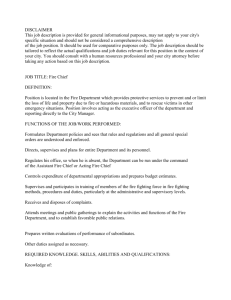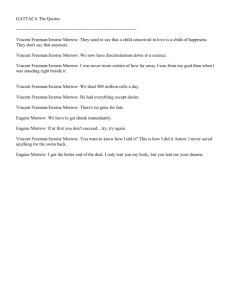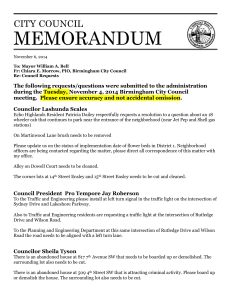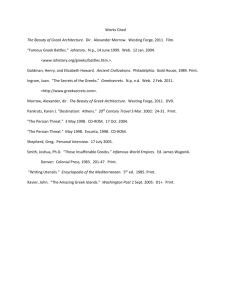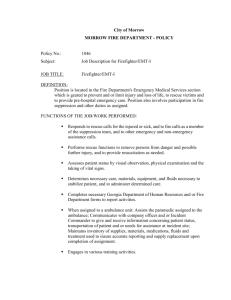Dwight Whitney Morrow - Englewood Public Library
advertisement
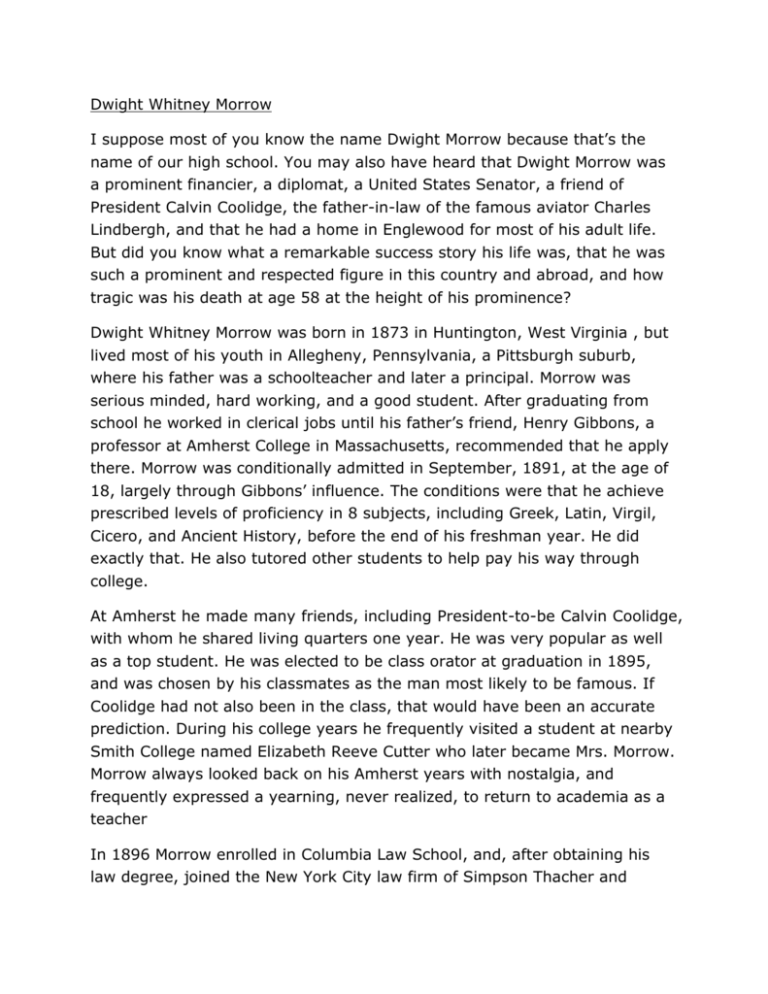
Dwight Whitney Morrow I suppose most of you know the name Dwight Morrow because that’s the name of our high school. You may also have heard that Dwight Morrow was a prominent financier, a diplomat, a United States Senator, a friend of President Calvin Coolidge, the father-in-law of the famous aviator Charles Lindbergh, and that he had a home in Englewood for most of his adult life. But did you know what a remarkable success story his life was, that he was such a prominent and respected figure in this country and abroad, and how tragic was his death at age 58 at the height of his prominence? Dwight Whitney Morrow was born in 1873 in Huntington, West Virginia , but lived most of his youth in Allegheny, Pennsylvania, a Pittsburgh suburb, where his father was a schoolteacher and later a principal. Morrow was serious minded, hard working, and a good student. After graduating from school he worked in clerical jobs until his father’s friend, Henry Gibbons, a professor at Amherst College in Massachusetts, recommended that he apply there. Morrow was conditionally admitted in September, 1891, at the age of 18, largely through Gibbons’ influence. The conditions were that he achieve prescribed levels of proficiency in 8 subjects, including Greek, Latin, Virgil, Cicero, and Ancient History, before the end of his freshman year. He did exactly that. He also tutored other students to help pay his way through college. At Amherst he made many friends, including President-to-be Calvin Coolidge, with whom he shared living quarters one year. He was very popular as well as a top student. He was elected to be class orator at graduation in 1895, and was chosen by his classmates as the man most likely to be famous. If Coolidge had not also been in the class, that would have been an accurate prediction. During his college years he frequently visited a student at nearby Smith College named Elizabeth Reeve Cutter who later became Mrs. Morrow. Morrow always looked back on his Amherst years with nostalgia, and frequently expressed a yearning, never realized, to return to academia as a teacher In 1896 Morrow enrolled in Columbia Law School, and, after obtaining his law degree, joined the New York City law firm of Simpson Thacher and Bartlett. In 1903, ten years after they had first met, he married Elizabeth Cutter. Finding that acceptable living quarters in Manhattan were too expensive, they accepted the advice of a friend, John Kerr, and looked for a place to start their married life in Kerr’s home town of Englewood Their first residence was the house which can still be seen at 71 Spring Lane. Morrow could walk to the train station to commute to Manhattan. The Morrows later moved to a house on Palisade Avenue which is no longer in existence, before building their mansion on Next Day Hill. Morrow’s career at Simpson Thacher progressed rapidly, and his income rose to meet the needs of a growing family (four children eventually). He took on continually increasing responsibilities, becoming a partner in 1905. He was not a courtroom lawyer, but achieved a reputation for the thoroughness of his research and the cogency and economy of his briefs and for his ability to find solutions to difficult legal and financial problems. Morrow’s big chance came when in 1913 he was offered a partnership in J. P. Morgan & Co., which made him suddenly a national figure. To understand why this was so you have to appreciate what an immensely powerful force J. P. Morgan & Co. was in that era. As an investment and commercial bank, Morgan dealt with nearly all the large corporations in the country and with governments and companies abroad. When President Theodore Roosevelt had decided in 1902 to dust off the Sherman Anti-Trust Act and prove his trust busting credentials, he wanted maximum publicity. The target he thus chose in the headline-producing Northern Securities case was J. P. Morgan & Co. And there was the famous time in 1907 when, to avoid a financial panic, Mr. Morgan invited the heads of the New York banks and trust companies to a meeting and would not let them leave until they had committed funds to a rescue package. This episode was a main reason for the creation of the Federal Reserve System some years later. After World War I started, France and Great Britain made substantial purchases of armaments and supplies in this country, and it was J. P. Morgan & Co. that acted as purchasing agent and provided the extensive financing involved. At the time Morrow joined the firm, J. P. Morgan himself, who had created this powerful enterprise, had recently died, and his son and namesake was seeking talented younger men to insure the firm’s future success. Morrow had become acquainted with Morgan partners Henry P. Davison and Thomas Lamont, who lived in Englewood, and they were largely responsible for recruiting him. As a Morgan partner, Morrow handled some of the firm’s most important clients. He gained particular acclaim for achieving the highly complex mutualization of the Equitable Life Assurance Society, and for a major reorganization of the copper industry resulting in the creation of Kennecott Copper Corporation. Morrow, although a valued and active Morgan partner, was always drawn to public affairs. According to Ron Chernow, author of The House of Morgan, “he belonged to a 1920′s cult that believed in the wisdom of businessmen as managers of America’s political affairs.” “He wrote essays, gave speeches, joined foreign policy councils and served on foundation boards.” In 1917 he chaired a commission investigating the state prison system in New Jersey. In his usual thorough fashion, he interviewed prison inmates and guards, prison officials and experts in penology. The commission’s recommendations for prison reform were adopted and copied by other states. After the U. S. entered World War I, he devoted his talents to the war effort. He played a major role in the Allied Maritime Transport Council, which was charged with allocating scarce shipping. The shipping shortage had become acute as a result of German submarine warfare. He then became General Pershing’s chief civilian aide, moving to France and providing invaluable assistance in the area of logistics. Always interested in politics, in 1920 Morrow became involved in an effort to nominate his friend Calvin Coolidge for President in the Republican Convention. Although the Convention nominated Warren Harding, Coolidge was chosen to run for Vice President. They were both elected, and Coolidge succeeded to the presidency in 1923 when Harding died in office. In 1925, Morrow was asked by President Coolidge to head a board to investigate the country’s aviation policy. Colonel Billy Mitchell, who had headed the army’s air effort in the recent war, had stirred up considerable controversy and antagonism from the military and naval hierarchies, with his contention that future wars would be won by air power. Mitchell actually acquired an obsolete battleship and sank it with aerial bombs to demonstrate his point. Although Mitchell was court-martialed for insubordination, and later died in obscurity, Morrow’s committee tried to tone down the shrillness of the controversy, considered Mitchell’s point of view, and recommended reforms, including the separation of civil from military aviation and the creation of separate air services in the Army and Navy, which were largely adopted. In 1927, Morrow resigned from J. P. Morgan and took on his most famous role, Ambassador to Mexico. Morrow thrived on challenges, and accepted this one at Coolidge’s request. Morrow had shown in an earlier financial crisis with Cuba an ability to resolve difficult problems in Latin America. Relations with our larger neighbor to the south had been difficult for some years, as the revolutionary government and political instability had made life difficult for foreign investors, and heavy-handed U. S. policy had created much mistrust in Mexico . Mexico had defaulted on debts, nationalized Catholic Church properties, and confiscated lands and oil rights owned by U. S. companies and citizens. There was sentiment in some circles for military intervention. Morrow, on the other hand, set about making friends, President Calles in particular, and endeavoring to understand the Mexican point of view. To quote Morrow’s biographer, Harold Nicholson, “From the first moment of his arrival it became obvious even to the most nationalistic Mexican that Morrow had come to placate, to appreciate, and to please. His insatiable friendliness, his utter simplicity, the very exuberance of his good will, held them enthralled.” In his three years there he was able to negotiate settlement of a number of outstanding disputes, including one between the Vatican and the Mexican government. At one point he incurred the wrath of his former partner, Thomas Lamont, while negotiating settlement of a debt dispute in which Morgan was involved. He gained considerable personal popularity in Mexico as well as esteem in the U. S. The villa at Cuernavaca was where the Morrows spent their weekends and vacations was retained by the family after his death. Before leaving on his new mission, Morrow had invited Charles Lindbergh, newly returned from his famous solo flight across the Atlantic, to visit him in Mexico. Lindbergh flew down to Mexico City and received much acclaim from the Mexicans. While he was there he courted Morrow’s daughter, Anne, to whom he eventually became engaged. Their marriage on May 27, 1929, in the Morrows’ new home at Next Day Hill could have been the great social event of the era if the newlyweds had not deliberately misled the media and departed surreptitiously on their honeymoon. Their effort to completely escape media surveillance by traveling in a boat to the family home in North Haven, Maine, was, however, unsuccessful. They were discovered and hounded by boats and seaplanes. While still in Mexico, Morrow was approached to run as a Republican for Senator in New Jersey. He agreed and was elected to fill an unexpired term, serving only from December 3, 1930 until his death on October 5, 1931. He died suddenly from a cerebral hemorrhage at the age of 58. Five months after his death, the Lindbergh’s first child was kidnapped. The kidnapping, the child’s death, the search for and capture of the alleged killer, and the trial, conviction and execution of Bruno Richard Hauptman was the leading continuing crime story of the early nineteen thirties. Morrow appeared twice on the cover of Time magazine, once in 1925 when he chaired the aviation investigation, and again in 1930 when, as a senatorial candidate, he became the first prominent Republican to advocate repeal of the Eighteenth (prohibition) Amendment. Public sentiment had by 1930 turned against prohibition, and Democratic candidates across the country were seizing on the issue. Morrow’s leadership in this regard caused public speculation over his potential as a Republican Presidential candidate in 1932. Despite all his other commitments, Morrow was active in the affairs of Englewood, at one point chairing a successful drive to raise $1,000,000 for the Englewood Hospital. At the time of his death Englewood had committed to the building of a new high school, and it was logical to name the new school after Englewood’s recently deceased most famous citizen. Morrow was a remarkable man in many respects. At all stages of his life, people were impressed by his unusual combination of high intelligence with personal warmth. He was short in stature, often careless of his appearance, and famously absent minded. He wore pince nez and had a professorial manner. He became quite wealthy through his Morgan partnership, but making money was never his prime object. His approach to life was that of a problem solver, studying a problem in all its aspects and then devising a solution which was acceptable to all those involved. As we would say today, he did his homework. Morrow once wrote in a letter to his son “The world is divided into people who do things and people who get the credit. Try if you can to belong to the first class. There’s far less competition.” Of course Morrow himself belonged to both classes. He did things, and he got the credit.
